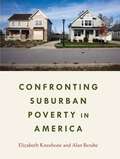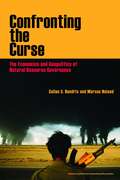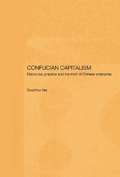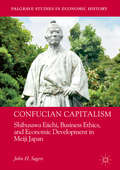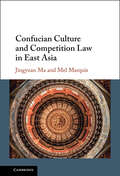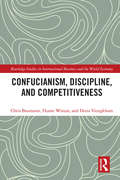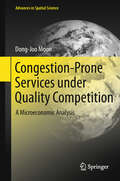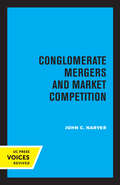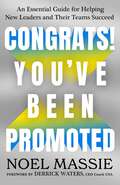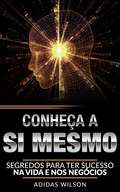- Table View
- List View
Confronting Suburban Poverty in America
by Elizabeth Kneebone Alan BerubeIt has been nearly a half century since President Lyndon Johnson declared war on poverty. Back in the 1960s tackling poverty "in place" meant focusing resources in the inner city and in rural areas. The suburbs were seen as home to middle- and upper-class families--affluent commuters and homeowners looking for good schools and safe communities in which to raise their kids. But today's America is a very different place. Poverty is no longer just an urban or rural problem, but increasingly a suburban one as well. In Confronting Suburban Poverty in America, Elizabeth Kneebone and Alan Berube take on the new reality of metropolitan poverty and opportunity in America.After decades in which suburbs added poor residents at a faster pace than cities, the 2000s marked a tipping point. Suburbia is now home to the largest and fastest-growing poor population in the country and more than half of the metropolitan poor. However, the antipoverty infrastructure built over the past several decades does not fit this rapidly changing geography. As Kneebone and Berube cogently demonstrate, the solution no longer fits the problem.The spread of suburban poverty has many causes, including shifts in affordable housing and jobs, population dynamics, immigration, and a struggling economy. The phenomenon raises several daunting challenges, such as the need for more (and better) transportation options, services, and financial resources. But necessity also produces opportunity--in this case, the opportunity to rethink and modernize services, structures, and procedures so that they work in more scaled, cross-cutting, and resource-efficient ways to address widespread need. This book embraces that opportunity.Kneebone and Berube paint a new picture of poverty in America as well as the best ways to combat it. Confronting Suburban Poverty in America offers a series of workable recommendations for public, private, and nonprofit leaders seeking to modernize poverty alleviation and community development strategies and connect residents with economic opportunity. The authors highlight efforts in metro areas where local leaders are learning how to do more with less and adjusting their approaches to address the metropolitan scale of poverty--for example, integrating services and service delivery, collaborating across sectors and jurisdictions, and using data-driven and flexible funding strategies."We believe the goal of public policy must be to provide all families with access to communities, whether in cities or suburbs, that offer a high quality of life and solid platform for upward mobility over time. Understanding the new reality of poverty in metropolitan America is a critical step toward realizing that goal."--from Chapter One
Confronting Suburban Poverty in America
by Elizabeth Kneebone Alan BerubeIt has been nearly a half century since President Lyndon Johnson declared war on poverty. Back in the 1960s tackling poverty "in place" meant focusing resources in the inner city and in rural areas. The suburbs were seen as home to middle- and upper-class families-affluent commuters and homeowners looking for good schools and safe communities in which to raise their kids. But today's America is a very different place. Poverty is no longer just an urban or rural problem, but increasingly a suburban one as well. In Confronting Suburban Poverty in America, Elizabeth Kneebone and Alan Berube take on the new reality of metropolitan poverty and opportunity in America.After decades in which suburbs added poor residents at a faster pace than cities, the 2000s marked a tipping point. Suburbia is now home to the largest and fastest-growing poor population in the country and more than half of the metropolitan poor. However, the antipoverty infrastructure built over the past several decades does not fit this rapidly changing geography. As Kneebone and Berube cogently demonstrate, the solution no longer fits the problem.The spread of suburban poverty has many causes, including shifts in affordable housing and jobs, population dynamics, immigration, and a struggling economy. The phenomenon raises several daunting challenges, such as the need for more (and better) transportation options, services, and financial resources. But necessity also produces opportunity-in this case, the opportunity to rethink and modernize services, structures, and procedures so that they work in more scaled, cross-cutting, and resource-efficient ways to address widespread need. This book embraces that opportunity.Kneebone and Berube paint a new picture of poverty in America as well as the best ways to combat it. Confronting Suburban Poverty in America offers a series of workable recommendations for public, private, and nonprofit leaders seeking to modernize poverty alleviation and community development strategies and connect residents with economic opportunity. The authors highlight efforts in metro areas where local leaders are learning how to do more with less and adjusting their approaches to address the metropolitan scale of poverty-for example, integrating services and service delivery, collaborating across sectors and jurisdictions, and using data-driven and flexible funding strategies."We believe the goal of public policy must be to provide all families with access to communities, whether in cities or suburbs, that offer a high quality of life and solid platform for upward mobility over time. Understanding the new reality of poverty in metropolitan America is a critical step toward realizing that goal."-from Chapter One
Confronting The Curse: The Economics and Geopolitics of Natural Resource Governance
by Marcus Noland Cullen HendrixCountries blessed with abundant natural resources often seek financial and political power from their supposedly lucky status. But the potentially negative impact of natural resources on development of poor countries is captured in the phrase "the resource curse." Instead of success and prosperity, producers of gold, oil, rubber, sugar, and other commodities-many in the least developed parts of Africa and Asia-often remain mired in poverty and plagued by economic mismanagement, political authoritarianism, foreign exploitation, and violent conflict. These difficulties and the many challenges they pose for American foreign policy are the focus of this important new book. Marcus Noland and Cullen S. Hendrix review recent developments as poor countries struggle to avoid the "resource curse" but fall too often into that trap. They call for support for international efforts to encourage greater transparency and improved management of natural resource wealth and for new partnerships between the West and the developing world to "confront the curse."
Confronting a Necessary Evil: The Firing of Alex Robins (A)
by Joshua D. MargolisA manager recounts his experience firing the person he was asked to replace and reflects on the challenges of the experience. Teaching Purpose: To role-play and reflect on tasks that entail harming other people to fulfill one's responsibility.
Confronting a Necessary Evil: The Firing of Alex Robins (A)
by Joshua D. MargolisA manager recounts his experience firing the person he was asked to replace and reflects on the challenges of the experience. Teaching Purpose: To role-play and reflect on tasks that entail harming other people to fulfill one's responsibility.
Confronting a Necessary Evil: The Firing of Alex Robins (B)
by Joshua D. MargolisA manager recounts his experience firing the person he was asked to replace and reflects on the challenges of the experience. Teaching Purpose: To role-play and reflect on tasks that entail harming other people to fulfill one's responsibility.
Confronting a Necessary Evil: The Firing of Alex Robins (B)
by Joshua D. MargolisA manager recounts his experience firing the person he was asked to replace and reflects on the challenges of the experience. Teaching Purpose: To role-play and reflect on tasks that entail harming other people to fulfill one's responsibility.
Confronting the Climate Challenge: U.S. Policy Options
by Lawrence Goulder Marc HafsteadWithout significant reductions of greenhouse gas emissions, climate change will cause substantial damage to the environment and the economy. The scope of the threat demands a close look at the policies capable of reducing the harm. Confronting the Climate Challenge presents a unique framework for evaluating the impacts of a range of U.S. climate-policy options, both for the economy overall and for particular household groups, industries, and regions. Lawrence Goulder and Marc Hafstead focus on four alternative approaches for reducing carbon dioxide emissions: a revenue-neutral carbon tax, a cap-and-trade program, a clean energy standard, and an increase in the federal gasoline tax. They demonstrate that these policies—if designed correctly—not only can achieve emissions reductions at low cost but also can avoid placing undesirable burdens on low-income household groups or especially vulnerable industries.Goulder and Hafstead apply a multiperiod, economy-wide general equilibrium model that is distinct in its attention to investment dynamics and to interactions between climate policy and the tax system. Exploiting the unique features of the model, they contrast the shorter- and longer-term policy impacts and focus on alternative ways of feeding back—or “recycling”—policy-generated revenues to the private sector. Their work shows how careful policy design, including the judicious use of policy-generated revenues, can achieve desired reductions in carbon dioxide emissions at low cost, avoid uneven impacts across household income groups, and prevent losses of profit in the most vulnerable U.S. industries. The urgency of the climate problem demands comprehensive action, and Confronting the Climate Challenge offers important insights that can help elevate policy discussions and spur needed efforts on the climate front.
Confronting the Curse: The Economics and Geopolitics of Natural Resource Governance
by Marcus Noland Cullen HendrixCountries blessed with abundant natural resources often seek financial and political power from their supposedly lucky status. But the potentially negative impact of natural resources on development of poor countries is captured in the phrase "the resource curse." Instead of success and prosperity, producers of gold, oil, rubber, sugar, and other commodities—many in the least developed parts of Africa and Asia—often remain mired in poverty and plagued by economic mismanagement, political authoritarianism, foreign exploitation, and violent conflict.These difficulties and the many challenges they pose for American foreign policy are the focus of this important new book. Marcus Noland and Cullen S. Hendrix review recent developments as poor countries struggle to avoid the "resource curse" but fall too often into that trap. They call for support for international efforts to encourage greater transparency and improved management of natural resource wealth and for new partnerships between the West and the developing world to "confront the curse."
Confucian Capitalism: Discourse, Practice and the Myth of Chinese Enterprise (Chinese Worlds)
by Souchou YaoThe discourse of Confucian Capitalism has been crucial in shaping our understanding of the brilliant economic successes of the Chinese diaspora all over the world. From this perspective, hard work, family values, and communal cohesion, as well as business practices based on sentiment, trust, and social networks, are the legendary means of explaining the wealth and commercial talent of these remarkable people. The book examines the subject of Chinese business' by exposing the enduring myth about the determining effects of these values and practices supposedly derived from Confucianism. Such myth relies on an ahistorical and essentialised notion of Chinese Culture', and brings into focus three sites of controversy: the economically driven Chinese subject, work-place relations characterised by consensus and cultural sharing, and an operating ethos of collectivist, pre-capitalist sociality. In its interrogation of the discourse of Confucian capitalism, it is the aim of this book to arrive at a critically informed and socially realistic understanding of Chinese business. The author combines abstract analysis with examples from anthropological fieldwork among Chinese traders in Sarawak, East Malaysia. By anchoring theoretical discussion to real case-studies, the multi-disciplinary approach of this book offers a useful insight into Chinese business activities, and contributes to current debates in cultural studies, economic anthropology, the economic performance of overseas Chinese, and neo-Confucian societies more generally.
Confucian Capitalism: Shibusawa Eiichi, Business Ethics, and Economic Development in Meiji Japan (Palgrave Studies in Economic History)
by John H. SagersWith the life story of Shibusawa Eiichi (1840–1931), one of the most important financiers and industrialists in modern Japanese history, as its narrative focal point, this book explores the challenges of importing modern business enterprises to Japan, where the pursuit of profit was considered beneath the dignity of the samurai elite. Seeking to overturn the Tokugawa samurai-dominated political economy after the Meiji Restoration, Shibusawa was a pioneer in introducing joint-stock corporations to Japan as institutions of economic development. As the entrepreneurial head of Tokyo’s Dai-Ichi Bank, he helped launch modern enterprises in such diverse industries as banking, shipping, textiles, paper, beer, and railroads. Believing businesses should be both successful and serve the national interest, Shibusawa regularly cautioned against the pursuit of profit alone. He insisted instead on the ‘unity of morality and economy’ following business ethics derived from the Confucian Analects. A top leader in Japan’s business community for decades, Shibusawa contributed to founding the Tokyo Stock Exchange, the Tokyo Chamber of Commerce, and numerous educational and philanthropic organizations to promote his vision of Confucian capitalism. This volume marks an important contribution to the international debate on the extent to which capitalist enterprises have a responsibility to serve and benefit the societies in which they do business. Shibusawa's story demonstrates that business, government, trade associations, and educational institutions all have valuable roles to play in establishing a political economy that is both productive and humane.
Confucian Culture and Competition Law in East Asia
by Mel Marquis Jingyuan MaCompetition law is a significant legal transplant in East Asia, where it has come into contact with deeply rooted variants of Confucian culture. This timely volume analyses cultural factors in mainland China, Japan and Korea, focusing on their shared but diversely evolved Confucian heritage. These factors distinguish the competition law systems of these countries from those of major western jurisdictions, in terms of the goals served by the law, the way enforcement is structured, and the way subjects of the law respond to it. Concepts from cultural studies inform a new and eclectic perspective on these dynamics, with the authors also drawing on ideas from law and economics, comparative law, East Asian studies, political science, business management and ethics, and institutional economics. The volume presents a model for cultural analysis of comparative legal topics and contributes to a greater understanding of the challenges to deeper convergence of competition laws between East and West.
Confucianism, Discipline, and Competitiveness (Routledge Studies in International Business and the World Economy)
by Chris Baumann Hume Winzar Doris ViengkhamThe importance of competitiveness has increased rapidly in recent years, where a fresh look at the different forms in which competitiveness manifests is needed. Though the exceptional growth of East Asian economies has been hypothesised previously from a socio-cultural perspective, links have often been vague with little empirical evidence to support them. This book proposes that a unique paradigm of competitiveness has developed in the East as a result of the cultural traditions and social values influenced by Confucianism, and extends this hypothesis by exploring a critical missing link: the role of discipline. Based on data from the Programme for International Student Assessment (PISA) and World Economic Forum (WEF), this book sheds light on important insights, through empirical evidence, that culture and discipline play an important role toward a country’s academic performance, and ultimately, competitiveness. In comparing six geographical clusters, this book analyses data by applying the "Inter-ocular Test" – visualisation of data distributions – to supplement traditional statistical mean comparisons. The findings advance the discourse on culture and performance, by drawing attention to the significant impact that improving discipline can have for a nation’s productivity–not only those of Confucian East Asia. Written with the evolving global economy in mind, this book highlights the relevance of discipline for shaping individual productivity for the future workforce, and offers new perspectives on how this can be achieved for all societies through three key contributions: Taxonomy of Discipline dimensions, "Parent-Engagement-School-Discipline Taxonomy" (PESD), and Wheel of Competitiveness. Building on the authors’ prior works, this book offers a comprehensive look at three interrelated concepts: Confucianism, Discipline, and Competitiveness, and how they relate to performance in East Asia. Written in an accessible style, this book will be a valuable guide for students, educators, practitioners, and policy-makers who seek to further understand the valuable role of discipline in shaping the success of societies, present and future.
Confucius Advising The Manager: Part I (Confucius #1)
by Claudio Pardo MolinaThis book provides practical advice for the daily management of a company. Managers have to deal with ethical or moral issues all the time and do not necessarily have the academic background to respond to these challenges. Because of this, I wrote this book with a series of recommendations for decision making based on Confucius' millenarian book "Analects". It is as if we were lucky enough to be able to hire as external consultant the wise Confucius, born more than 2000 years ago.
Confucius Lives Next Door: What Living in the East Teaches Us About Living in the West
by T. R. ReidThose who've heard T. R. Reid's weekly commentary on National Public Radio or read his far-flung reporting in National Geographic or The Washington Post know him to be trenchant, funny, and cutting-edge, but also erudite and deeply grounded in whatever subject he's discussing. In Confucius Lives Next Door he brings all these attributes to the fore as he examines why Japan, China, Taiwan, and other East Asian countries enjoy the low crime rates, stable families, excellent education, and civil harmony that remain so elusive in the West. Reid, who has spent twenty-five years studying Asia and was for five years The Washington Post's Tokyo bureau chief, uses his family's experience overseas--including mishaps and misapprehensions--to look at Asia's "social miracle" and its origin in the ethical values outlined by the Chinese sage Confucius 2,500 years ago. When Reid, his wife, and their three children moved from America to Japan, the family quickly became accustomed to the surface differences between the two countries. In Japan, streets don't have names, pizza comes with seaweed sprinkled on top, and businesswomen in designer suits and Ferragamo shoes go home to small concrete houses whose washing machines are outdoors because there's no room inside. But over time Reid came to appreciate the deep cultural differences, helped largely by his courtly white-haired neighbor Mr. Matsuda, who personified ancient Confucian values that are still dominant in Japan. Respect, responsibility, hard work--these and other principles are evident in Reid's witty, perfectly captured portraits, from that of the school his young daughters attend, in which the students maintain order and scrub the floors, to his depiction of the corporate ceremony that welcomes new employees and reinforces group unity. And Reid also examines the drawbacks of living in such a society, such as the ostracism of those who don't fit in and the acceptance of routine political bribery. Much Western ink has been spilled trying to figure out the East, but few journalists approach the subject with T. R. Reid's familiarity and insight. Not until we understand the differences between Eastern and Western perceptions of what constitutes success and personal happiness will we be able to engage successfully, politically and economically, with those whose moral center is governed by Confucian doctrine. Fascinating and immensely readable, Confucius Lives Next Door prods us to think about what lessons we might profitably take from the "Asian Way"--and what parts of it we want to avoid.
Confusion de Confusiones [1688]: Portions Descriptive of the Amsterdam Stock Exchange
by Jose De La VegaJoseph Penso de la Vega, best known as Joseph de la Vega (ca. 1650-1692), was a successful Jewish merchant, poet, and philanthropist residing in 17th century Amsterdam. He became famous for his masterpiece "Confusion of Confusions" the oldest book ever written on the stock exchange business. Although not a descriptive account of the process of stock trading, Penso presented the history of speculation in stocks and acquainted the reader with the sophisticated financial instruments used. The dialogue format allowed the reader to understand the respective perspectives of the various market participants and the intricacies of speculation and trading. Penso also came up with four basic rules of the share market that are still of the greatest relevance today: The first rule in speculation is: Never advise anyone to buy or sell shares. Where guessing correctly is a form of witchcraft, counsel cannot be put on airs. The second rule: Accept both your profits and regrets. It is best to seize what comes to hand when it comes, and not expect that your good fortune and the favorable circumstances will last. The third rule: Profit in the share market is goblin treasure: at one moment, it is carbuncles, the next it is coal; one moment diamonds, and the next pebbles. Sometimes, they are the tears that Aurora leaves on the sweet morning's grass, at other times, they are just tears. The fourth rule: He who wishes to become rich from this game must have both money and patience. Includes Foreword by Hermann Kellenbenz.-Print ed.
Congeniando con otros: Cómo trabajar con personas que no soportas
by James Christiansen¿Estas estrezado y tienes una vida abrumadora? ¿Estas teniendo problemas para enfrentar todo lo que haces? ¡Es hora de aprender cómo relajar y reducir estrés! Admitámoslo: el estrés esta alrededor de nosotros. La vida moderna está inmersa en situaciones estresantes y casi todos nosotros somos afectados por el estrés en un momento u otro de manera negativa. Lamentablemente, muchas personas buscan liberar el estrés a través de malos hábitos, como comer de más, abuso de drogas y alcohol. Ciertamente hay medicamentos disponibles que también pueden ayudar en casos de estrés severo, pero ¿qué hay de las curas naturales, holísticas, no medicinales? Allí es donde este libro te ayudará: este libro te mostrará los mejores métodos libres de medicamentos para enseñarte a trabajar con el estrés, todas de las cuales incorporan las energía naturales y sus propiedades curativas. ¿Qué mejor manera de combatir el estrés que con tus propias recursos y habilidades naturales? Aprenderás acerca de cómo estas técnicas pueden ayudarte a combatir el estrés: Acupuntura Terapia de masaje Yoga Risa ¡y más! Adicionalmente, hay enlaces dentro del libro para encontrar profesionales certificados en estas terapias así como recursos adicionales. Si estás sufriendo de estrés y buscando soluciones, no busques más. Necesitas aprender a aliviar el estrés y eso empieza leyendo este libro. ¡Este libro te dará las respuestas de las técnicas que pueden ayudarte a combatir siempre el estrés por el resto de tu vida!
Congestion-Prone Services under Quality Competition: A Microeconomic Analysis (Advances in Spatial Science)
by Dong-Joo MoonThis study presents new microeconomic analyses of congestion-prone services that comprise most private and public services at the final consumption stage. It accounts for two distinctive features of congestion-prone services: the discrepancy between capacity and throughput, and service quality competition. To accommodate these features, a series of new decision-making theorems for consumers and suppliers is developed. The resulting demand and cost functions incorporate service time as the variable that reflects congestion and service quality. In market equilibrium, interactions between consumers and firms endogenously determine the industrial organization type of each firm and thus allow the coexistence of multiple industrial organization types in the same market. Efficiency of resource allocation is assessed by applying two different criteria: service quality diversity throughout the market and Pareto optimality in each submarket.
Conglomerate Mergers and Market Competition
by John C. NarverBusiness mergers are nowadays much in fashion and in the news, but relatively litte is known about their effects on different aspects of business enterprise, especially their effects on market competition. Narver her distinguishes among three main types of corporate merger: the horizontal, involving firms that produce generally similar items; the vertical, involving a successive (e.g. supplier-customer) relationship between firms and the conglomerate, involving any merger that is neither horizontal nor vertical. Economist have yet to agree on a general definition of the essential aspects of conglomerate mergers or on an adequate description of their effects on competition. the present book derives a precise meaning of conglomerate mergers by analyzing the legislative concern in the 1950 Amendment to Section 7 of the Clayton Act. The book then carefully considers the several factors in conglomerate merges that lead to their ability to affect competition. Most importantly, this analysis suggests under what conditions conglomerate mergers increase competition in a market and under what conditions they lessen it. With notable vigor and patience the author has pieced together various aspects of statistics on conglomerate merge activity, managerial behavior in a diversified firm, and market structure, and has produced the most useful analysis available on the competitive effects of conglomerate mergers. Not everyone will agre with its findings, but here can be no question that legislators, antitrust lawyers, economists, and business people will find them useful. Narver's book is timely because of wide concern with the current wave of mergers, appropriate public policy, and efficient private decision-making. Serval important conglomerate merger cases are now before the courts, and the public policy issues involved are still in the process of clarification. The analysis presented in this book should be important in the discussions of the next several years. This title is part of UC Press's Voices Revived program, which commemorates University of California Press's mission to seek out and cultivate the brightest minds and give them voice, reach, and impact. Drawing on a backlist dating to 1893, Voices Revived makes high-quality, peer-reviewed scholarship accessible once again using print-on-demand technology. This title was originally published in 1967.
Congoleum Corp.
by Robert F. Bruner David W. Mullins Jr.Describes the development and terms of the largest leveraged buyout up to the date of the case. The main problem is to value the positions of the various participants: lenders, equity holders, investment bankers, and management.
Congoleum Corp. (Abridged)
by William E. FruhanDescribes the development and terms of the largest leveraged buyout up to the date of the case. The main problem is to value the positions of the various participants: lenders, equity holders, investment bankers, and management. This is an abridged version of an earlier case by D.W. Mullins, Jr.
Congrats! You've Been Promoted: An Essential Guide for Helping New Leaders and Their Teams Succeed
by Noel MassieNoel Massie&’s Congrats! You&’ve Been Promoted! is an essential guide for equipping new managers with the tools and strategies to lead their teams successfully.Getting promoted is one of the most exciting events in a career. Yet many are placed in the role without any knowledge of what it takes to be a leader, let alone a great leader. You&’re expected to sink or swim, and most companies don&’t provide any support or leadership training either before or after the promotion. You want to be an excellent leader for your team, but where can you find the basic tools and strategies you need? Author Noel Massie, former vice president of operations for UPS, has walked in your shoes. And he knows what it takes to lead with both wisdom and confidence. Congrats! You&’ve Been Promoted is the trusty, must-have guide for every new leader. It&’s a mentor on your bookshelf! With professional and personal anecdotes, pertinent research, and exercises that help reinforce the concepts, Massie uses his signature straightforward style to impart the leadership lessons he learned during his six-decade career, such as: Understanding your team&’s terms and conditions, and your own Establishing trust with your team Providing regular, actionable feedback Leveraging the B.E.S.T. Principle to keep discussions with employees focused and positive Applying the 4x5 Method to capture multiple perspectives on any situation . . . and many more. Give yourself the gift of starting off your leadership journey on the right foot. Your success—and that of your team—depend on it! For more information on Noel Massie&’s Webinar and Masterclass content, visit NoelMassie.com.
Congressional Candidate Dan Silver and KNP Communications
by Amy J.C. Cuddy Nithyasri SharmaIn the 2006 election cycle, Dan Silver was challenging a popular 26-year incumbent for the U.S. congressional seat in Florida's 19th Congressional District. To win the election, Silver needed to find a way to relate to his voters on a personal level. Silver's campaign manager advised him to work with consulting firm KNP Communications. Over the course of a few sessions, Silver worked with the KNP team to learn techniques that would help him project warmth and authenticity. On election night, Silver wondered if KNP's training had allowed him to successfully connect with his voters, and more importantly, if this personal connection mattered more to voters than his competence and skills. Some information in this case has been disguised.
Congruence Model Note
by James Weber Shon R. HiattThis note describes the Congruence Model, a method by which an organization can assess whether its building blocks (critical tasks, formal organizational arrangements, people, and culture) are aligned (congruent) with its strategy. The model postulates that misalignments are at the root of performance gaps within the organization.
Conheça a Si Mesmo - Segredos para ter sucesso na vida e nos negócios
by Adidas WilsonFique longe de pessoas tóxicas e negativas. Eles são chamados de vampiros de sonhos. Eles farão tudo o que está no alcance deles para impedi-lo. Eu adormeci e saí de uma ponte dirigindo um caminhão de 18 rodas. Caí nos trilhos e fui atingido por um trem. Acabei quebrando minhas costas e fiquei dois anos de muletas. Mas eu ainda não desisti. Às vezes nossas metas podem levar cinco ou dez anos. Mas eventualmente os seus sonhos se tornarão realidade. O sucesso é parecido com a droga mais potente do planeta. Eu quero tanto ter sucesso que posso literalmente sentir o gosto das estrelas! O trabalho é apenas meu ganha pão. Não me sinto confortável trabalhando para outra pessoa. Não me sinto confortável batendo ponto para outra pessoa. Isto é uma mentalidade; Independentemente do que esteja por dentro você deve se dar um impulso para que você se torne “Mestre de si mesmo”. "Homem, conhece a ti mesmo, assim conhecerá os deuses". Provérbio egípcio. “Quando você quiser ter sucesso tanto quanto quer respirar, então você terá sucesso!” Eric Thomas
